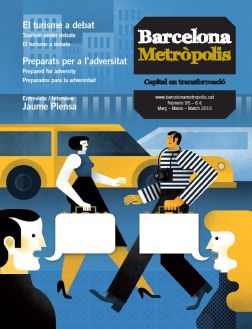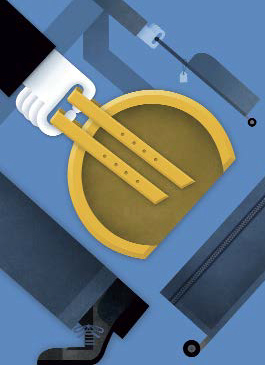As long as our tourism sector is based on the creation of poorly-paid jobs, not only does it create scant value but redistributes this to the benefit of tourists and tourist operators, and to the detriment of the rest of society. The current model is leading us to a serious conflict.
We might classify tourism in Barcelona into different models: cruise, congress, architectural and cultural, shopping, stag-parties-and-low-cost-weekends, etc. Each of them has very different characteristics that experts are passionate about and are crucial to workers in the sector. Being neither one nor the other, my point of view is that of a citizen who has to live with tourism, and whose income depends only very indirectly on it. From this standpoint, there are only two tourist models: a good one and a bad one. A good one is that which creates a great deal of value and distributes it properly among the citizens, and a bad one is that which creates little value and distributes it poorly. Tourism in Barcelona is the bad kind, although it is up to us to make it good.
Let us examine this step by step. Tourism creates value and has costs, hence the key is to maximise the former and minimise the latter. It creates value because it creates jobs and because tourists pay to enjoy our heritage: our environment, our setting. Tourism has costs because tourists interfere with the selfsame beauty that they pursue, they cause bottle-necks and make products more expensive. It is all well and good that tourists can eat out near Park Güell, but it is a crying shame that an 8 euro park entry fee has to be charged to restore peace and quiet there.
We have statistics that measure how much tourists – particularly foreign tourists – spend, and since the figures are very high, politicians, representatives from the sector and journalists shout these figures loudly at every opportunity. However, the value created by tourism is not the same as tourist spending. In the latter, the money that does not remain in Barcelona has to be discounted: fuel and the depreciation of the airplane or cruise liner, the cost of the imported articles they buy in Passeig de Gràcia or La Roca Village, and so on. The best way to calculate the value created by tourism is to add up the take-home wages or salaries of tourism workers, the profits of all the companies that operate in tourism and the taxes collected by the public administrations. In our case, this value is low.
It is low because the main part of this value lies in the wages paid to workers that look after tourists, which generally speaking are very low. Very low and very seasonal. Unfortunately, this is an statement that cannot be backed up by reliable statistics, because not only do such statistics not exist, but it would also be difficult to generate them, since “tourism sector worker” is an ambiguous concept: to what extent is a shop assistant on Passeig de Gràcia a tourist worker? What about a newspaper stand worker on the Rambla? Or a taxi driver?
Nevertheless, there are many signs that point us in the right direction: they are provided by the wage data of highly-seasonal sectors (such as hotels, catering companies and restaurants), regions highly dependent on tourism (such as the Balearic Islands) and specific groups: employees hired to serve drinks in beach bars, room-service workers subcontracted by hoteliers, among others.
Finally, we have the macroeconomic figures. For example, income from tourism per capita is no greater in Catalonia than it is in Austria (about 1,750 euros per capita per year) although the pressure from tourism is much more intense in Catalonia than in Austria. The reason is clear: an Austrian waiter earns much more than their Catalan counterpart. Having reached this point, the question is inevitable and crystal-clear: if Barcelona is much more attractive than Vienna, why should tourist workers be paid less to do the exact same job?
A perverse redistribution of value
Tourism has created a lot of jobs, there is no doubting that. But most of these jobs have been taken up by immigrants. I have already said that one cannot speak with any certainty about the tourism employment market, although in this case the signs are also unmistakeable. For example, the following piece of data: so far this century, the number of jobs created in Spain by the sectors usually equated with tourism tallies exactly with the increase in the number of foreign workers. This fact seriously limits the benefits that the wider society of Barcelona obtains from tourism.
But that is not all. The overall impact of low-income workers on society in general is even more important. To summarise: over the course of their life, a person that earns less than 1,200 euros a month will pay much less in taxes (above all due to the VAT charged on what they consume) than the public education, health and social expenditure they will generate. Seasonal workers are entitled to a pension that is greater than the value of the contributions they make. This is all simply the result of a social structure that protects people who earn less and is what characterises us as a civilised society, but it is wholly relevant to any analysis of the distribution of wealth generated by tourism: when a tourist pays for a service rendered by a worker who is earning less than 1,200 euros a month, or who is seasonal, they are being subsidised, as the service provided by that person actually costs more.
Or, to put it another way: to the extent that our tourism is based on the creation of poorly-paid jobs (most of them held by immigrants) not only does tourism create little value, it also yields a redistribution of value that works to the benefit of tourists (and tourism business operators) and against the rest of society, whose impoverishment is embodied in the form of increasingly more congested social services and precarious pensions. The residents of the Barceloneta district protested at the nuisance caused by tourists. What they did not know was that they are also making them poorer.
What is to be done?
Barcelona’s tourism assets are exceptional, as is the success reaped by private and public managers in promoting them. Nevertheless, our tourism creates scant value and is distributed perversely. The solution cannot come from businesses, because this would require either raising the minimum wage or increasing the tax burden. A waiter in Vienna earns more than in Barcelona not thanks to their skill handling a tray, but because that is the way things are. On the subject of taxes, when AENA doubled the rates at El Prat airport and the Catalan Government levied the wrongly-named tourist tax, apocalyptic predictions were heard, although the number of visitors has continued to show unstoppable growth. Businesses do not lose out because they can pass the costs on to the tourist. And tourists will not stop coming to Barcelona just because beer gets more expensive here; if this were the case, they would also stop going to Vienna.
I have been asked to give a prediction for the next 10 years. No doubts here: if we stick to the current model of minimising wages and maximising the number of tourists, then we are headed for a very serious conflict, as this model benefits the few and jeopardises the many. If we manage to pass back to the tourists the real costs they incurr then we, the inhabitants of Barcelona, will be paying a reasonable price for living in a popular city.





Pingback: Quo Vadis Barcelona? | Núvol